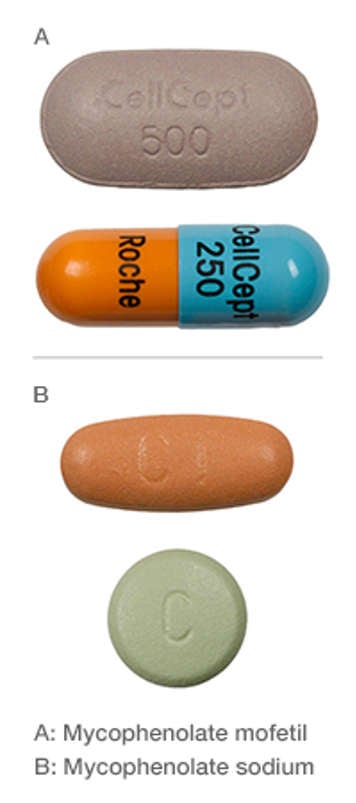
Two types of medications contain mycophenolate:
- mycophenolate mofetil (also known as MMF, Cellcept®)
- mycophenolate sodium (also known as Myfortic®).
What is mycophenolate?
Mycophenolate works by preventing your body from rejecting your new organ. It is called an immunosuppressant or an anti-rejection medication.
What mycophenolate looks like
Mycophenolate can come in a tablet, capsule or liquid. Here are photos of two brands used after transplant: Cellcept® and Myfortic®.
Note: These photos are close-ups of the medications; they are not to scale.
How to take mycophenolate
- Wash your hands before and after handling mycophenolate.
- Take mycophenolate every 12 hours at the same times every day.
- You can take mycophenolate with food or without food, but make sure you take it the same way every day. Taking it with food may reduce any stomach upset (such as cramps or diarrhea) and will mean it passes into your blood more slowly.
- Take magnesium, iron and antacids at least 2 hours before or after your mycophenolate doses.
- You may be prescribed one brand of mycophenolate right after transplant and another brand at a later time. Make sure you always take the same brand until your transplant team tells you change it. Discuss this with your community pharmacist so that you always receive the same brand when you refill your prescription.
- Call your transplant team if you notice that the mycophenolate capsule, tablet or liquid looks different from what you normally take.
Taking mycophenolate tablets or capsules
- Swallow the tablets or capsules whole.
- Never open the capsules or cut or crush the tablets.
Taking mycophenolate suspension (liquid)
- Shake the bottle well before each dose.
- Use the syringe provided with your medicine to measure your dose.
- Wash away any liquid left on your hands right after you take it.
Once it is mixed, mycophenolate suspension is stable for 60 days at room temperature. The pharmacist will put an expiry label on the bottle to help you remember when it is no longer safe to take it.
Possible side effects of mycophenolate
- Nausea (upset stomach), vomiting (throwing up)
- Stomach cramps
- Diarrhea (watery stools)
- Heartburn
- Tiredness or fatigue – mycophenolate can lower your hemoglobin, also known as your red blood cell count (hemoglobin provides energy to the body)
- Heavier or longer bleeding from any cuts – mycophenolate can lower your platelet count (platelets help stop bleeding)
- Greater risk of infections – mycophenolate lowers your white blood cell count (white blood cells help fight infection), which is more common than any changes to your red blood cells or platelets
- Mild headache
- Dizziness
- Higher blood sugar (less common)
- Lower phosphorus levels in your blood (less common)
- Higher or lower potassium levels in your blood (less common)
How to store mycophenolate
- Keep mycophenolate out of reach of any small children.
- Keep mycophenolate at room temperature.
- Store it in a cool, dry place away from sunlight.
- Never store it in the bathroom or near heat sources in the kitchen.
- Never store it in the refrigerator or freezer.






